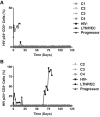Comprehensive analysis of unique cases with extraordinary control over HIV replication
- PMID: 22490332
- PMCID: PMC3367872
- DOI: 10.1182/blood-2011-10-381996
Comprehensive analysis of unique cases with extraordinary control over HIV replication
Abstract
True long-term nonprogressors (LTNPs)/elite controllers (ECs) maintain durable control over HIV replication without antiretroviral therapy. Herein we describe 4 unique persons who were distinct from conventional LTNPs/ECs in that they had extraordinarily low HIV burdens and comparatively weak immune responses. As a group, typical LTNPs/ECs have unequivocally reactive HIV-1 Western blots, viral loads below the lower threshold of clinical assays, low levels of persistent viral reservoirs, an over-representation of protective HLA alleles, and robust HIV-specific CD8(+) T-cell responses. The 4 unique cases were distinguished from typical LTNPs/ECs based on weakly reactive Western blots, undetectable plasma viremia by a single copy assay, extremely low to undetectable HIV DNA levels, and difficult to isolate replication-competent virus. All 4 had at least one protective HLA allele and CD8(+) T-cell responses that were disproportionately high for the low antigen levels but comparatively lower than those of typical LTNPs/ECs. These unique persons exhibit extraordinary suppression over HIV replication, therefore, higher-level control than has been demonstrated in previous studies of LTNPs/ECs. Additional insight into the full spectrum of immune-mediated suppression over HIV replication may enhance our understanding of the associated mechanisms, which should inform the design of efficacious HIV vaccines and immunotherapies.
Figures






References
-
- Migueles SA, Connors M. Long-term nonprogressive disease among untreated HIV-infected individuals: clinical implications of understanding immune control of HIV. JAMA. 2010;304(2):194–201. - PubMed
Publication types
MeSH terms
Grants and funding
LinkOut - more resources
Full Text Sources
Medical
Research Materials

